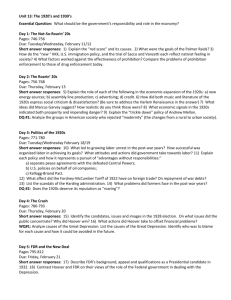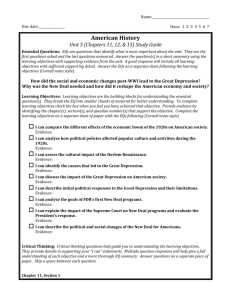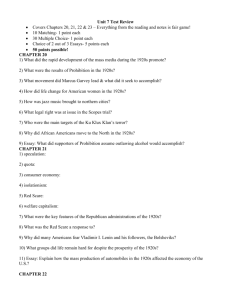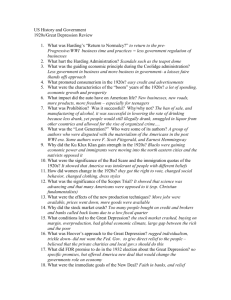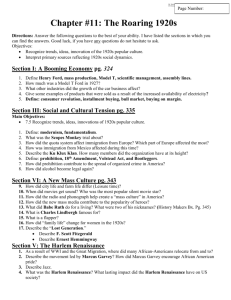Unit 4
advertisement
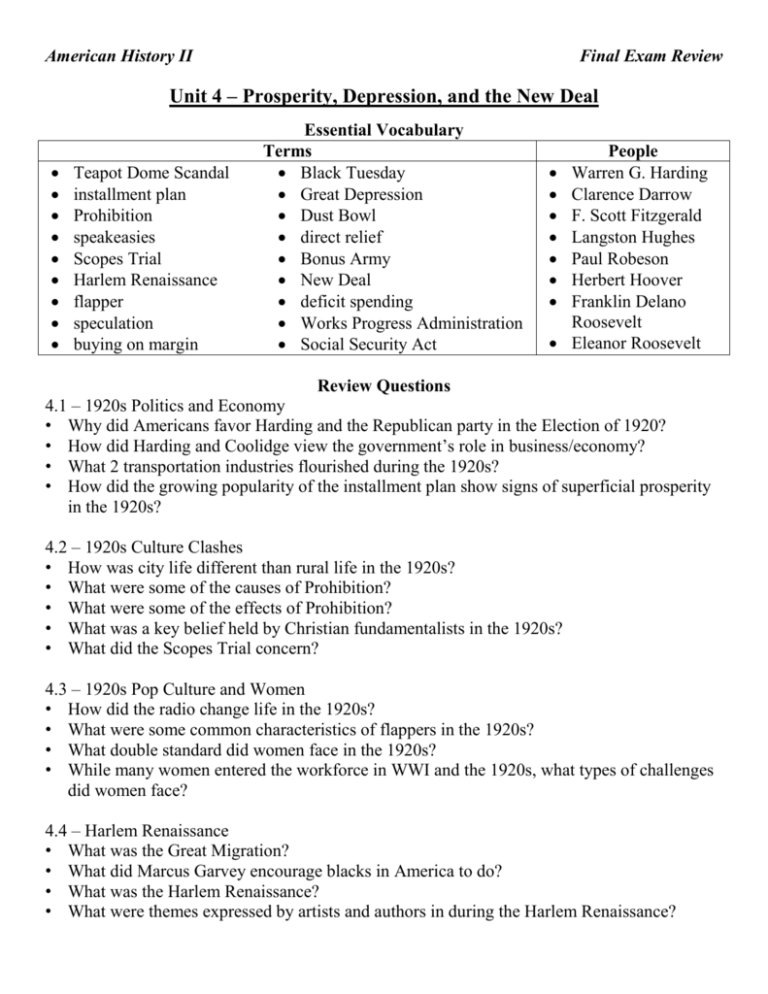
American History II Final Exam Review Unit 4 – Prosperity, Depression, and the New Deal Teapot Dome Scandal installment plan Prohibition speakeasies Scopes Trial Harlem Renaissance flapper speculation buying on margin Essential Vocabulary Terms Black Tuesday Great Depression Dust Bowl direct relief Bonus Army New Deal deficit spending Works Progress Administration Social Security Act People Warren G. Harding Clarence Darrow F. Scott Fitzgerald Langston Hughes Paul Robeson Herbert Hoover Franklin Delano Roosevelt Eleanor Roosevelt Review Questions 4.1 – 1920s Politics and Economy • Why did Americans favor Harding and the Republican party in the Election of 1920? • How did Harding and Coolidge view the government’s role in business/economy? • What 2 transportation industries flourished during the 1920s? • How did the growing popularity of the installment plan show signs of superficial prosperity in the 1920s? 4.2 – 1920s Culture Clashes • How was city life different than rural life in the 1920s? • What were some of the causes of Prohibition? • What were some of the effects of Prohibition? • What was a key belief held by Christian fundamentalists in the 1920s? • What did the Scopes Trial concern? 4.3 – 1920s Pop Culture and Women • How did the radio change life in the 1920s? • What were some common characteristics of flappers in the 1920s? • What double standard did women face in the 1920s? • While many women entered the workforce in WWI and the 1920s, what types of challenges did women face? 4.4 – Harlem Renaissance • What was the Great Migration? • What did Marcus Garvey encourage blacks in America to do? • What was the Harlem Renaissance? • What were themes expressed by artists and authors in during the Harlem Renaissance? American History II Final Exam Review 4.5 – Causes of the Great Depression • What were the 4 long-term causes of the Great Depression? • Why was Hoover (a man who had never held an elected office) overwhelmingly elected as the 31st POTUS in 1928? • What were some problems with investing the stock market in the 1920s? • What series of events caused banks to collapse after Black Tuesday? 4.6 – Life During the Great Depression • All Americans suffered during the Great Depression, but minorities were hit especially hard. Why? • How did the Dust Bowl exacerbate (make worse) the effects of the Great Depression? • In what ways was the American family changed by the Great Depression (consider men, women, and children)? 4.7 – Hoover’s Failed Response • What type of role did Hoover believe the gov’t should play in the economy and society? • What is the theory of trickle-down economics? • Which Americans made up the Bonus Army that marched on DC in 1932? What did they want? • How did Americans react to Hoover’s handling of the Bonus Army? 4.8 – FDR’s New Deal • What was FDR’s “Brain Trust?” • What were the 3 R’s of the FDR’s New Deal? • What was the purpose of FDR’s fireside chats? • For what reasons did some American dislike FDR’s New Deal? 4.9 – FDR’s Second New Deal • Why did FDR believe a Second New Deal was necessary? • What did the Works Progress Administration (WPA) do? • What 3 types of aid did the Social Security Act provide? 4.10 – Effects of the New Deal • Why was FDR cautious when approaching civil rights for African Americans? • In what ways did labor unions support FDR? • Why, in 1939, did the New Deal end? • What were the 2 legacies left by the New Deal? 4.11 – 1930s Culture What types of entertainment were popular in the 1930s? What was Orson Welles’ War of the Worlds and how did it affect listeners? What types of art did the Federal Art Project sponsor? What themes were present?


